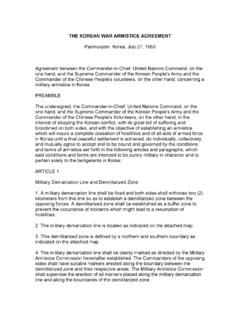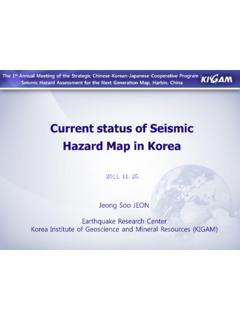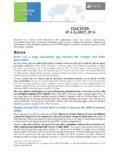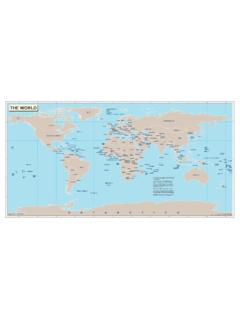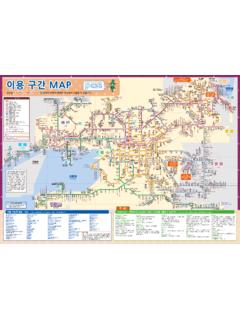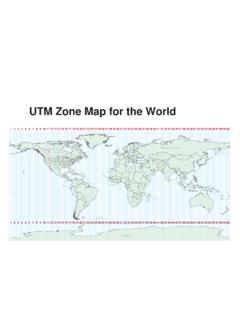Transcription of OECD Economic Surveys KOREA
1 OECD Economic SurveysKOREA JUNE 2014 OVERVIEW This document and any map included herein are without prejudice to the status of or sovereignty over any territory, to the delimitation of international frontiers and boundaries and to the name of any territory, city or area. The statistical data for Israel are supplied by and under the responsibility of the relevant Israeli authorities. The use of such data by the OECD is without prejudice to the status of the Golan Heights, East Jerusalem and Israeli settlements in the West Bank under the terms of international law.
2 OECD 2014 1 Summary Main findings Key recommendations OECD 2014 2 Main findings KOREA has been among the fastest growing OECD countries during the past decade. However, subdued growth during 2011-12 revealed structural problems, such as high household debt, a lagging service sector and weak small and medium-sized enterprises (SMEs). This has raised concerns about KOREA 's traditional catch-up strategy led by exports produced by large chaebol companies. In addition, KOREA has experienced a rise in relative poverty and income inequality since 1997, although both have fallen recently.
3 The new growth strategy aims at fostering a creative economy , in which venture businesses play a key role, accompanied by greater emphasis on social cohesion, including increased social spending and a roadmap to boost employment. Such initiatives will support the current upturn, while promoting KOREA 's long-term convergence to the most advanced countries and enhancing social cohesion and well-being. Fostering a creative economy While R&D spending was the highest in the OECD, at of GDP in 2012, weaknesses in the innovation system limit the return. International collaboration in patenting and research is low and the role of universities is small.
4 Framework conditions to promote a creative economy are also weak, reflecting relatively stringent product market regulations and low inward foreign direct investment. The creation of new enterprises is hampered by problems in the venture capital market and SME financing. The productivity gap between large firms and SMEs, which benefit from a wide range of public support, is widening, reflecting problems in services. Indeed, service sector productivity is only about half of that in manufacturing. Greenhouse gas emissions and energy intensity have been rising despite the 2009-13 green growth plan. Promoting social cohesion and well-being KOREA has a dualistic labour market, with non-regular workers accounting for a third of employment, contributing to high wage dispersion and low female labour participation.
5 Public social spending as a share of GDP is less than half of the OECD average and has had a relatively small impact on income inequality and relative poverty, particularly among the elderly whose rate is 49%. Only about a quarter of the elderly receive benefits from the National Pension Scheme, reflecting its low coverage, while the company pension system is still at an early stage. Household debt, at 164% of disposable income, has a social dimension as financial institutions have become reluctant to lend to households with low income and poor credit ratings and the number of delinquent household borrowers remains sizable. Sustaining the Economic expansion Output growth has returned to close to 4%.
6 However, KOREA is vulnerable to the fragile global situation and exchange rate shifts, while high household debt poses a headwind to growth. The goal of balancing the central government budget (excluding social security) has been delayed until after 2017. The fiscal situation, nevertheless, remains strong with a general government budget surplus in 2012 and gross debt of only of GDP. Inflation, which has fallen to 1%, is projected to rise to the target zone of OECD 2014 3 Key recommendations Fostering a creative economy Gradually scale back and streamline government support to SMEs, while concentrating it on firms at an early stage of development and avoiding long-term public support.
7 Entry barriers to chaebol-affiliated firms should be phased out. Make the recently-established KOREA New Exchange an important funding source for start-ups by ensuring an appropriate level of investor protection. Improve the innovation framework by expanding the role of universities, upgrading government research institutes and strengthening international linkages. Increase the return on investment in innovation by easing product market regulations, thereby facilitating the re-allocation of resources. Improve vocational education and training to meet the needs of SMEs and facilitate the use of the Internet to enhance their growth.
8 Take further steps to improve the business environment. In particular, develop the service sector by leveling the playing field with manufacturing and strengthening competition by eliminating entry barriers, accelerating regulatory reform and reducing barriers to trade and FDI. Implement the Emissions Trading System as planned in 2015, align carbon taxation in sectors not covered by the System with the System and further raise electricity prices to at least cover production costs. Promoting social cohesion and well-being Break down labour market dualism by reducing employment protection for regular workers and by increasing social insurance coverage and training for non-regular workers.
9 Raise the employment rate, particularly for women, by creating high-quality part-time jobs and improving the quality of childcare. Target the Basic Old-Age Pension benefit on the lowest-income elderly to ensure that they escape absolute poverty. Increase the coverage of the National Pension Scheme and maintain the replacement rate at around 50%. Raise the contribution rate to meet rising pension outlays. Expand company pensions and strengthen personal pension plans. Address the household delinquent debt problem while limiting moral hazard and containing the growth of household debt. Sustaining the Economic expansion Achieve the 2017 target of reducing the consolidated central government budget deficit (excluding the social security surplus) to close to zero, so long as the current expansion is sustained.
10 If downside risks materialise, further relax monetary policy and implement short-term fiscal stimulus. Carefully consider the costs and benefits of any further accumulation of foreign exchange reserves. OECD 2014 4 Assessment and Recommendations KOREA 's Economic expansion and macroeconomic policies to sustain it A new Economic paradigm for KOREA : Fostering a creative economy Promoting social cohesion and well-being OECD 2014 5 KOREA 's economy has rebounded with growth at around 4% since mid-2013 (Figure 1). There is concern, though, that the problems that constrained growth during 2011-12 weak domestic demand due to high household debt, stagnant service sector productivity and struggling small and medium-sized enterprises (SMEs) will remain.










